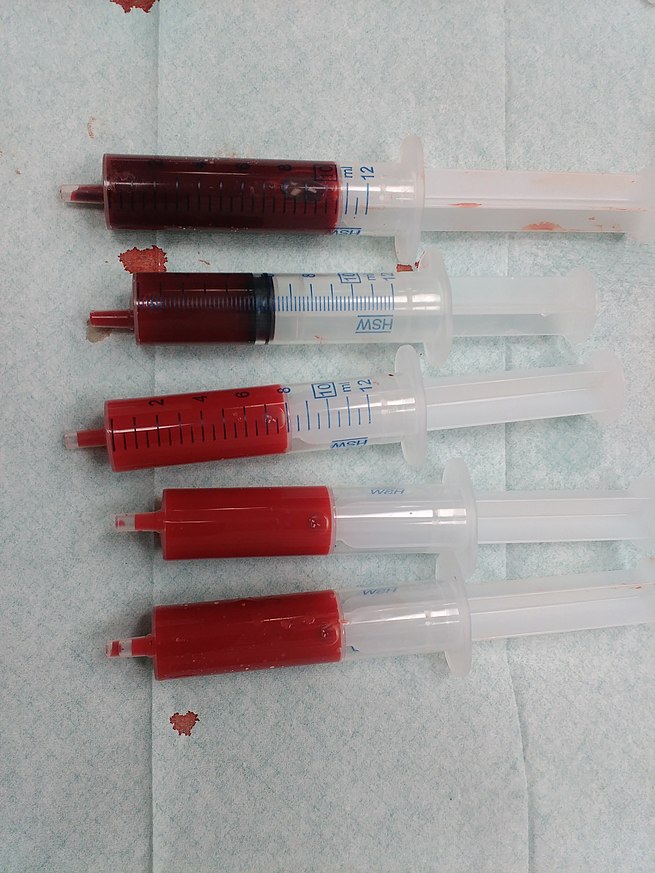Main Difference
The main difference between Blood and Lymph is that the Blood is a organic fluid which transports nutrients throughout the organism and Lymph is a fluid that circulates throughout lymphatic system
-
Blood
Blood is a body fluid in humans and other animals that delivers necessary substances such as nutrients and oxygen to the cells and transports metabolic waste products away from those same cells.In vertebrates, it is composed of blood cells suspended in blood plasma. Plasma, which constitutes 55% of blood fluid, is mostly water (92% by volume), and contains proteins, glucose, mineral ions, hormones, carbon dioxide (plasma being the main medium for excretory product transportation), and blood cells themselves. Albumin is the main protein in plasma, and it functions to regulate the colloidal osmotic pressure of blood. The blood cells are mainly red blood cells (also called RBCs or erythrocytes), white blood cells (also called WBCs or leukocytes) and platelets (also called thrombocytes). The most abundant cells in vertebrate blood are red blood cells. These contain hemoglobin, an iron-containing protein, which facilitates oxygen transport by reversibly binding to this respiratory gas and greatly increasing its solubility in blood. In contrast, carbon dioxide is mostly transported extracellularly as bicarbonate ion transported in plasma.
Vertebrate blood is bright red when its hemoglobin is oxygenated and dark red when it is deoxygenated. Some animals, such as crustaceans and mollusks, use hemocyanin to carry oxygen, instead of hemoglobin. Insects and some mollusks use a fluid called hemolymph instead of blood, the difference being that hemolymph is not contained in a closed circulatory system. In most insects, this “blood” does not contain oxygen-carrying molecules such as hemoglobin because their bodies are small enough for their tracheal system to suffice for supplying oxygen.
Jawed vertebrates have an adaptive immune system, based largely on white blood cells. White blood cells help to resist infections and parasites. Platelets are important in the clotting of blood. Arthropods, using hemolymph, have hemocytes as part of their immune system.
Blood is circulated around the body through blood vessels by the pumping action of the heart. In animals with lungs, arterial blood carries oxygen from inhaled air to the tissues of the body, and venous blood carries carbon dioxide, a waste product of metabolism produced by cells, from the tissues to the lungs to be exhaled.
Medical terms related to blood often begin with hemo- or hemato- (also spelled haemo- and haemato-) from the Greek word αἷμα (haima) for “blood”. In terms of anatomy and histology, blood is considered a specialized form of connective tissue, given its origin in the bones and the presence of potential molecular fibers in the form of fibrinogen.
-
Lymph
Lymph (from Latin, lympha meaning “water”) is the fluid that flows through the lymphatic system, a system composed of lymph vessels (channels) and intervening lymph nodes whose function, like the venous system, is to return fluid from the tissues to the central circulation. Interstitial fluid – the fluid which is between the cells in all body tissues – enters the lymph capillaries. This lymphatic fluid is then transported via progressively larger lymphatic vessels through lymph nodes, where substances are removed by tissue lymphocytes and circulating lymphocytes are added to the fluid, before emptying ultimately into the right or the left subclavian vein, where it mixes with central venous blood.
Since the lymph is derived from the interstitial fluid, its composition continually changes as the blood and the surrounding cells continually exchange substances with the interstitial fluid. It is generally similar to blood plasma, which is the fluid component of blood. Lymph returns proteins and excess interstitial fluid to the bloodstream. Lymph also transports fats from the digestive system (beginning in the lacteals) to the blood via chylomicrons.
Bacteria may enter the lymph channels and be transported to lymph nodes, where the bacteria are destroyed. Metastatic cancer cells can also be transported via lymph.
-
Blood (noun)
A arteries and veins, is pumped by the heart and is usually generated in bone marrow.
“The cultists gathered around a chalice of blood.”
-
Blood (noun)
A family relationship due to birth, such as that between siblings; contrasted with relationships due to marriage or adoption (see blood relative, blood relation, by blood).
-
Blood (noun)
One of the four humours in the human body.
-
Blood (noun)
A blood test or blood sample.
-
Blood (noun)
The sap or juice which flows in or from plants.
-
Blood (noun)
The juice of anything, especially if red.
-
Blood (noun)
Temper of mind; disposition; mood
-
Blood (noun)
A lively, showy man; a rake; a dandy.
-
Blood (noun)
A blood horse, one of good pedigree.
-
Blood (noun)
Bloodshed.
“They came looking for blood.”
-
Blood (noun)
member of a certain gang.
-
Blood (verb)
To cause something to be covered with blood; to bloody.
-
Blood (verb)
To let blood (from); to bleed.
-
Blood (verb)
To initiate into warfare or a blood sport, traditionally by smearing with the blood of the first kill witnessed.
-
Lymph (noun)
Pure water.
-
Lymph (noun)
A colourless, watery bodily fluid, carried by the lymphatic system, that consists mainly of white blood cells.
-
Lymph (noun)
Discharge from a sore, inflammation etc.

